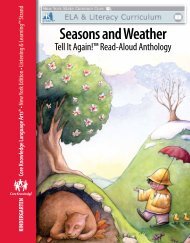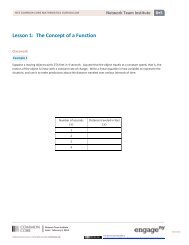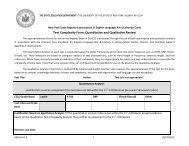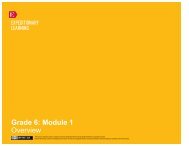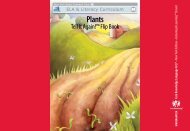Tell It Again! Read-Aloud Anthology - EngageNY
Tell It Again! Read-Aloud Anthology - EngageNY
Tell It Again! Read-Aloud Anthology - EngageNY
Create successful ePaper yourself
Turn your PDF publications into a flip-book with our unique Google optimized e-Paper software.
Show image 7A-3: Fast horses running<br />
7 The route is the way you go to get<br />
somewhere.<br />
8 So what does endurance mean?<br />
9 Do you think being a Pony Express<br />
rider would be an easy job or<br />
difficult and dangerous?<br />
After they decided which roads and trails to use, they had to set<br />
up stations along the route. 7 One rider left from California in the<br />
West, at the same time another rider left from Missouri. So riders<br />
traveled from both ends of the route to carry the mail as fast as<br />
possible.<br />
Finally, they had to hire riders and buy fast horses for them<br />
to ride. The horses were chosen for their endurance, or for their<br />
speed and their ability to continue on for a very long time. 8 Riders<br />
were usually young men, eighteen years old or younger. They had<br />
to be tough and loyal. 9 Riders would ride a leg, or small section, of<br />
this route, changing horses at each station.<br />
Show image 7A-4: Map showing the start of the Pony Express route<br />
10 [Trace the red line with your<br />
finger.] This is the route the riders<br />
took to carry the mail.<br />
11 A landmark is something in the<br />
landscape that can be used as a<br />
guiding point. [You may want<br />
to share a local landmark as an<br />
example.]<br />
This map shows the whole route of the Pony Express. <strong>It</strong> started<br />
in St. Joseph, Missouri, where the train tracks ended. The Pony<br />
Express went all the way to Sacramento, California. 10<br />
The thick red line on the map shows the route the riders<br />
followed. The pictures above and below the route show some<br />
landmarks the riders rode past. 11<br />
Show image 7A-5: Conditions that riders had to endure<br />
12 Why do you think boys chose to be<br />
Pony Express riders when it was<br />
such a hazardous job?<br />
13 What Native American tribe did<br />
you learn about that had their land<br />
taken away from them?<br />
Pony Express riders had to be ready to jump into the saddle<br />
and ride fifty miles on a moment’s notice. They rode in the<br />
scorching heat of the day. They rode at night, by the light of the<br />
moon. They rode through rain, hail, and sleet. They galloped<br />
across dusty deserts and zigzagged up dangerous mountain<br />
paths. They rode across wide-open prairie and through large<br />
herds of buffalo. There are stories of riders becoming lost in<br />
fierce blizzards and having to lead their horses on foot. 12 Native<br />
Americans watched these riders and saw it as more evidence of<br />
an endless flow of people moving onto their land. 13<br />
Westward Expansion 7A | The Pony Express 107<br />
© 2013 Core Knowledge Foundation




